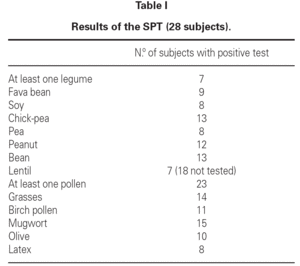INTRODUCTION
This study documented a lupin sensitisation rate of 4,1Lupin (Lupinus sp), a member of the Leguminosae family, is part of the Mediterranean diet and is also used as a thickener of wheat flour and other food products all over Europe. Though it has been recognised as a cause of serious allergic reactions, the prevalence of sensitisation and allergy is not documented1.
MATERIALS AND METHOD
This study aims at determining the prevalence of lupin sensitisation in a selected population. For 1 year (May 2005 to May 2006), all individuals consulting allergologists at Hospital Pulido Valente (Lisbon, Portugal) and performing skin prick tests (SPT) to air-borne and food allergens were further tested for lupin (commercial extract, IPI). In case of positivity to lupin, a clinical questionnaire was applied, the subjects were skin-prick-tested for other legumes (fava bean, pea, chick-pea, bean, soy, peanut and lentil), common inhalants and latex (commercial extract, BIAL) and lupin-specific IgE was measured (UNICAP).
RESULTS
In a population of 1,160 there were 48 subjects with positivity to lupin (4,1 % sensitisation rate), 39 of which answered clinical questionnaires (18 males, 21 females; average age 33.4). From these, 28 performed the additional SPT (see table I for results) and 12 measured specific IgE. Nine subjects (= 48-39) could not be contacted for the questionnaire, 11 (= 39-28) could not perform the additional SPT and a further 27 (= 39-12) could not measured lupin-specific IgE.
Among the 39 questioned subjects, 29 ingested lupin regularly without symptoms, 5 reported convincing symptoms of allergy (urticaria 2 patients, anaphylaxis 1, respiratory 1, abdominal pain and diarrhoea 1), 5 had never eaten lupin and all eat peanut without symptoms. All 5 patients with lupin allergy were pollen-sensitised and reported symptoms during the pollen season.
Measurement average of lupin-specific IgE was 1,6 kUA/L (min-0,10kUA/L, max-17,3kUA/L).
DISCUSSION AND CONCLUSIONS
The high (4,1 %) lupin sensitisation rate is comparable to peanut in a study of french subjects consulting allergologists2. As no systematic tolerance investigation through oral food challenge was carried out in the subjects not regularly eating lupin, the allergy prevalence could not be ascertained.
This study, like others, demonstrated a high (75 %) co-sensitisation between legumes3. However, its clinical implications could not be drawn, as subjects did not regularly eat all the tested legumes.
Among the 28 patients performing additional SPT, 23 (82.1 %) were also sensitised to at least one pollen, which suggests cross-reactivity. As previously documented for legumes, we find that all patients with lupin allergy are pollen-sensitised, which supports the hypothesis that pollen-leguminosae cross-reactivity might have clinical significance3.
Our latex sensitisation prevalence (28,5 %) comes close to that reported for risk groups for natural rubber latex allergy. The existence of cross-reactivity between latex and Leguminosae has already been documented in inhibition studies and could explain this result4.
To conclude, we find a high lupin sensitisation in 1,160 subjects consulting allergologists, thus stressing the importance of lupin as a food allergen.
Correspondence:
Ana M. Reis
Alamedadas Linhas de Torres, 117
1769001 Lisboa
AMSREIS@NET.SAPO.PT






